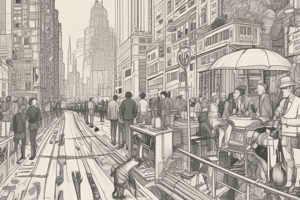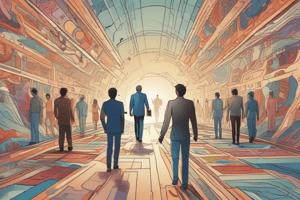Podcast
Questions and Answers
What characterizes an organization situated in a diverse environment?
What characterizes an organization situated in a diverse environment?
- It has a single product and serves one geographic area.
- It offers a greater variety of products, services, and clients. (correct)
- It primarily focuses on a local client base.
- It is less affected by market competition.
In which type of environment are organizations likely to face resource scarcity and higher competition?
In which type of environment are organizations likely to face resource scarcity and higher competition?
- Munificent environment
- Hostile environment (correct)
- Stable environment
- Integrated environment
How does organizational size influence job specialization and structure?
How does organizational size influence job specialization and structure?
- Job specialization increases with the number of employees. (correct)
- Smaller organizations do not have sophisticated structures.
- Larger organizations require less job specialization.
- Organizational size has no effect on structure.
What role does technology play in organizational structure design?
What role does technology play in organizational structure design?
How does organizational strategy relate to an organization's structure?
How does organizational strategy relate to an organization's structure?
What does centralization in an organizational structure refer to?
What does centralization in an organizational structure refer to?
Which element of organizational structure describes the number of employees a manager supervises directly?
Which element of organizational structure describes the number of employees a manager supervises directly?
What is a characteristic of a flat organizational structure?
What is a characteristic of a flat organizational structure?
What does formalization involve in an organizational setting?
What does formalization involve in an organizational setting?
Which of the following best describes departmentalization?
Which of the following best describes departmentalization?
In which structure is decision-making authority typically more dispersed?
In which structure is decision-making authority typically more dispersed?
What is a common advantage of a matrix organizational structure?
What is a common advantage of a matrix organizational structure?
How does the concept of division of labor relate to organizational structure?
How does the concept of division of labor relate to organizational structure?
What type of organizational structure is characterized by a narrow span of control and high formalization?
What type of organizational structure is characterized by a narrow span of control and high formalization?
Which type of departmentalization organizes employees based on geographical areas?
Which type of departmentalization organizes employees based on geographical areas?
In which type of environment are organic structures better suited due to their adaptability?
In which type of environment are organic structures better suited due to their adaptability?
What is a characteristic of a simple structure in organizational design?
What is a characteristic of a simple structure in organizational design?
Which structure is primarily built around self-directed teams completing entire work pieces?
Which structure is primarily built around self-directed teams completing entire work pieces?
What type of departmentalization would likely use a matrix approach to leverage multiple structures?
What type of departmentalization would likely use a matrix approach to leverage multiple structures?
Why should organizations decentralize in complex environments?
Why should organizations decentralize in complex environments?
Which of the following is an example of a divisional structure focused on client needs?
Which of the following is an example of a divisional structure focused on client needs?
Flashcards are hidden until you start studying
Study Notes
Organizational Structures and Systems
- Understanding organizational models is crucial for effective management and operational success.
- Different organizational structures include functional, multi-divisional, flat, matrix, team, network, and hierarchical models, each with distinct advantages and disadvantages.
Elements of Organizational Structure
- Division of Labor: Tasks are subdivided into separate jobs assigned to different individuals.
- Span of Control: Refers to the number of people directly reporting to a given manager; influences organization size and structure.
- Centralization: Centralized organizations have decision-making authority concentrated at the top, while decentralized structures distribute decision powers throughout.
- Formalization: Measures the extent of standardized behavior within the organization, differentiating between mechanistic (high formalization) and organic (low formalization) structures.
- Departmentalization: How activities and employees are grouped together, influencing coordination and efficiency.
Types of Departmentalization
- Simple Structure: Few employees, minimal hierarchy, focused on one product or service.
- Functional Structure: Employees organize around specific functions or expertise.
- Divisional Structure: Organized by geographic area, product lines, or client types, allowing for specialized operations.
- Geographic, Product, and Client Structures are sub-types of divisional organization.
- Team-Based Structure: Centers around self-directed teams responsible for completing whole work units.
- Matrix Structure: Combines two structures to exploit the benefits of both.
- Network Structure: Involves an alliance of multiple organizations to deliver a product or service.
External Environment Influences
- Dynamic vs. Stable Environments: Dynamic environments need organic structures for adaptability; stable environments are more predictable and can operate within rigid structures.
- Complex vs. Simple Environments: Complex systems involve numerous variables leading to a need for decentralized decision-making to manage demands effectively.
- Diverse vs. Integrated Environments: Diverse environments require firms to adapt structures that align with product and geographic diversity; integrated ones focus on singular service and product offerings.
- Hostile vs. Munificent Environments: Hostile environments face resource scarcity and competition, necessitating dynamic structures; munificent environments are resource-rich and stable.
Organizational Size and Technology
- Size impacts organizational structure; larger organizations typically necessitate more formalized processes and specialized roles.
- Technology influences organizational design based on how products or services are delivered, impacting efficiency and adaptability.
Organizational Strategy
- Strategy defines how an organization positions itself concerning stakeholders, drawing on its resources and capabilities to achieve goals.
- While size, technology, and environment guide structure decisions, organizational leaders ultimately shape the design to align with strategic objectives.
Studying That Suits You
Use AI to generate personalized quizzes and flashcards to suit your learning preferences.




